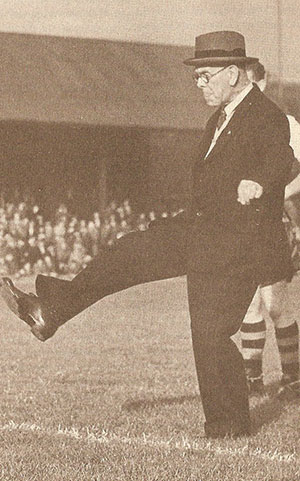BY TONY CANAVAN
Tom Clarke’s tobacconist shopfront to be restored
The government has provided €50,000 for the conservation and restoration of 55 Amiens Street, Dublin, once home to Tom Clarke, signatory of the 1916 Proclamation. Clarke operated a tobacconist’s shop from the building from 1908 to 1911. The funding is being made available under the Irish-language shopfront stream of the Historic Structures Fund (HSF). The funding will contribute to the conservation and restoration of the original Irish-language shopfront, while supporting the structural works necessary to safeguard the building. ‘When Tom Clarke had his shop here, it was illegal to have signage in Irish,’ Minister for Culture Catherine Martin said. ‘The restoration of this signage under the HSF not only commemorates an important chapter of our history but is a celebration of our language.’
Who’s sorry now?
The recent release of State Papers by the UK National Archives revealed that Tony Blair’s 1997 admission of the British government’s culpability concerning the Great Famine was neither written nor approved by the prime minister. It turns out that Mr Blair’s private secretary, Sir John Holmes, wrote the text. In May 1997, the newly elected prime minister was invited to send a message to the official commemoration of the Great Famine, held in Millstreet, Co. Cork. Blair’s statement was read on 31 May by actor Gabriel Byrne, as the prime minister was unable to attend. The request for a statement came at short notice and Sir John could not reach Mr Blair for his final approval. In Blair’s absence, Sir John said that he wanted to ‘avoid the impression of a snub’ and so approved the text himself. In part it said: ‘Those who governed in London at the time failed their people through standing by while a crop failure turned into a massive human tragedy’. Sir John considered this to be ‘no more than a statement of fact’. Nevertheless, at the time, and since, the statement has been both praised and criticised as an apology.
In the footsteps of James Connolly
A new heritage trail around locations in Belfast associated with James Connolly was launched this year. Devised by Áras Uí Chonghaile, the James Connolly Visitor Centre, it will be the first Belfast Heritage Trail powered by Augmented Reality, meaning that information and images appear on your mobile phone as you follow the trail. It highlights locations around Belfast associated with the renowned republican and trade union leader during his time in the city more than 100 years ago. The trail begins in Belfast City Hall and takes in Custom House Square, Sailortown and the docks area. It continues to Speaker’s Corner at Library Street and then up the Falls Road, past one of Belfast’s last remaining restored working mills, before arriving at the James Connolly Visitor Centre. You can download the free app from both iOS and Android app stores. For further information, visit arasuichonghaile.com/heritagetrail.
Sweating it out
A new research project is under way into the sweathouses of Ireland. One fact that has emerged already is that more than a third of the country’s sweathouses are located in County Leitrim. When archaeologist Aidan Harte started the Leitrim sweathouse project last June, he was aware of 98 examples in the county. He put together a team of 30 volunteers to collect and catalogue all existing information about the Leitrim sweathouses, and to gather oral history. They located six more, bringing the tally to 104. There are 292 known sweathouses across Ireland but there are only three in Kerry, for example, and one in Wicklow. Sweathouses, which were often beehive-shaped and built into hillsides, were usually located near water. It is believed that the patients trying to sweat out their ailments plunged into the water at the end of their treatment. The first documented references to sweathouses come from Frenchman Jacques-Louis de Bougrenet de La Tocnaye, who did a walking tour of Ireland in the 1790s. His diary notes: ‘Wherever there are four or five cabins near each other there is sure to be a sweating-house’. Sweathouses were heated by turf or wood and then, after the hot ashes were raked out, the patient entered and sweated for a designated period. Modern medicine, however, saw them fall out of favour. Sweathouses have been used in Ireland for centuries and it is interesting to note that ‘Turkish’ baths were often known as ‘Irish’ or ‘Roman-Irish’ baths across Europe.

Honouring a football legend
Fund-raising has begun to raise a statue to a hero of Newry and Celtic Football Club. A native of the County Down city, Willie Maley was the longest-serving manager of Celtic. Campaigners have begun to collect money for the tribute, while Newry, Mourne & Down District Council has provided a plot of land for a statue. Maley was the first manager of Celtic Football Club, and one of the most successful managers in Scottish football history. He led Celtic to 30 major trophies (sixteen league championships and fourteen Scottish Cups) in 43 consecutive years. He is credited with coining the Celtic motto, ‘It is not his creed nor his nationality which counts, it’s the man himself’. Born in 1868, Maley lived to the remarkable age of 90, dying in 1958.
